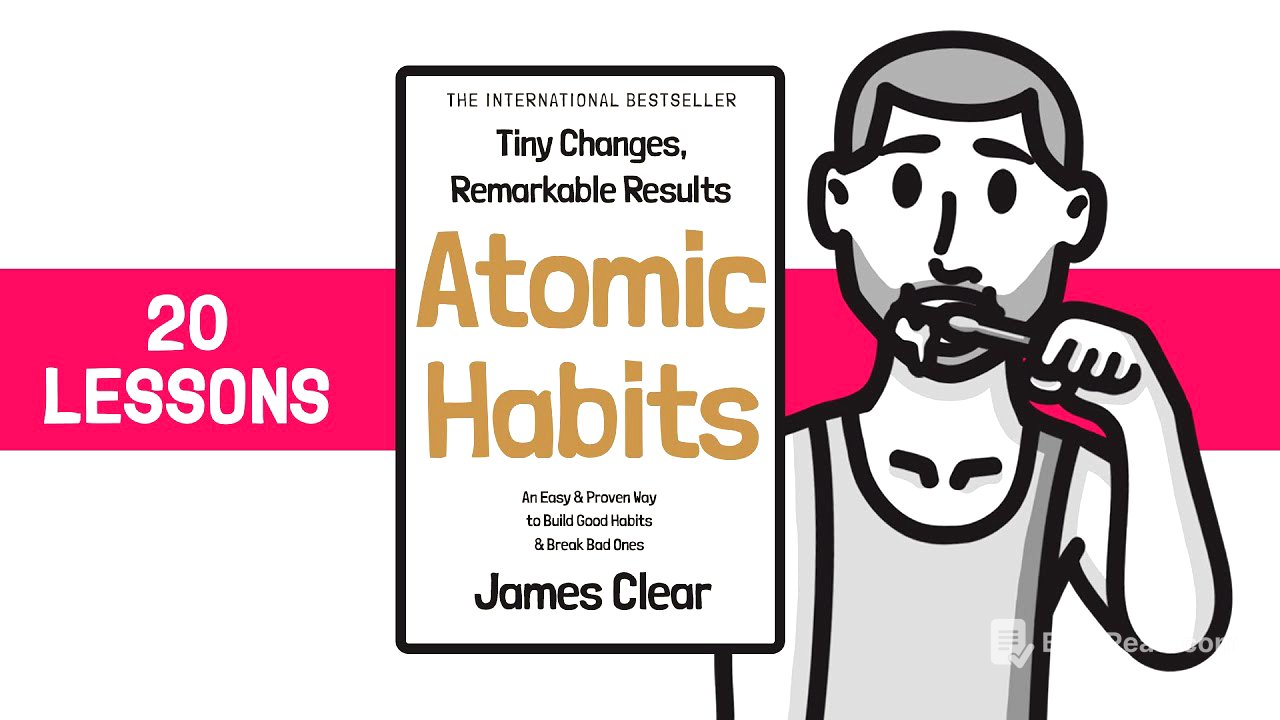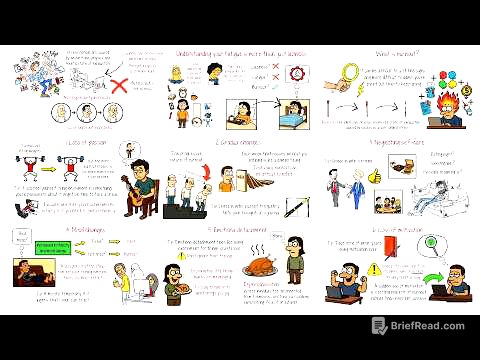TLDR;
This video provides a comprehensive guide on building and maintaining good habits, drawing heavily from the principles outlined in "Atomic Habits." It emphasizes the power of small changes, the importance of identity in shaping habits, and a four-step framework for building better habits: cue, craving, response, and reward. The video also covers strategies for starting new habits, designing your environment for success, and overcoming procrastination. Additionally, it touches on the role of accountability partners, the truth about talent, and the significance of continuous improvement and review.
- The power of small changes and atomic habits.
- The four-step framework: cue, craving, response, and reward.
- Strategies for starting new habits and designing your environment.
- Overcoming procrastination and the role of accountability.
- Continuous improvement and habit review.
Intro [0:00]
The intro sets the stage for a discussion on habits, highlighting their importance in personal development. It mentions various aspects of life, such as physical health, happiness, and memories, suggesting that habits play a crucial role in shaping these areas.
Chapter 1 - The Power of Atomic Habits [0:24]
The discussion emphasizes the significance of small habits and their cumulative effect over time. It suggests that even minor changes can lead to substantial improvements in various aspects of life. The concept of "atomic habits" is introduced, highlighting the power of these small, incremental changes.
Chapter 2 - How Habits Shape Your Identity [1:56]
This section explores the relationship between habits and identity. It suggests that habits not only shape our actions but also influence our self-perception and beliefs. The discussion touches on how the habits we cultivate contribute to our overall identity and how we see ourselves.
Chapter 3 - Build Better Habits in 4 Steps [2:45]
The video outlines a four-step framework for building better habits: cue, craving, response, and reward. It explains how each of these components plays a crucial role in the habit formation process. The discussion emphasizes the importance of understanding and manipulating these elements to create positive habits.
Chapter 4 - The Habit Loop [4:05]
This chapter describes the habit loop, which involves a trigger, a routine, and a reward. It explains how this loop works in our brains and how we can use it to our advantage when building new habits or breaking old ones. Understanding the habit loop is essential for making lasting changes in behavior.
Chapter 5 - Best Way to Start a New Habit [4:45]
The best way to start a new habit involves precise implementation and transformation. It is important to define exactly how and when the new habit will be implemented. This clarity helps in sticking to the new routine and making it a consistent part of your life.
Chapter 6 - Environment Over Motivation [5:33]
The environment plays a crucial role in habit formation, often outweighing motivation. Designing your surroundings to support good habits and eliminate temptations is key. This involves making positive cues more visible and accessible while minimizing exposure to negative influences.
Chapter 7 - The Secret of Self-Control [6:15]
Self-control is enhanced by making good habits invisible and minimizing exposure to temptations. Creating an environment that supports your goals reduces the need for constant willpower. This approach makes it easier to stick to positive behaviors and avoid negative ones.
Chapter 8 - How to Make a Habit Irresistible [7:35]
To make a habit irresistible, it should be aligned with personal values and integrated into daily life. Associating the habit with something enjoyable or rewarding can increase its appeal. This makes the habit more likely to stick and become a regular part of your routine.
Chapter 9 - The Role of Family and Friends [8:27]
Family and friends significantly influence our habits. Surrounding yourself with people who support your goals can reinforce positive behaviors. Conversely, associating with those who have negative habits can hinder progress.
Chapter 10 - How to Find and Fix Causes of Your Bad Habits [9:01]
Identifying and addressing the root causes of bad habits is essential for breaking them. This involves understanding the triggers and underlying needs that drive these habits. By addressing these causes, it becomes easier to replace negative behaviors with positive ones.
Chapter 11 - Walk Slowly But Never Backward [9:24]
The importance of consistent, forward progress, even if it's slow, is emphasized. The idea is to keep moving in the right direction and avoid regressing into old, negative patterns. This steady approach helps in building sustainable habits over time.
Chapter 12 - The Law of Least Effort [9:49]
The law of least effort suggests that people naturally gravitate towards options that require the least amount of work. To build good habits, make them as easy and convenient as possible. This reduces the friction associated with starting and maintaining these habits.
Chapter 13 - How to Stop Procrastinating [10:07]
To stop procrastinating, break tasks into smaller, more manageable steps. This makes the overall task seem less daunting and easier to start. By focusing on one small step at a time, you can overcome the inertia of procrastination and build momentum.
Chapter 14 - How to Make Good Habits Inevitable [10:45]
Making good habits inevitable involves designing your environment and routines to ensure they happen. This can include setting up cues and triggers that prompt the desired behavior. By making the good habit the default option, you increase the likelihood of following through.
Chapter 15 - The Cardinal Rule of Behaviour Change [11:11]
The cardinal rule of behavior change is to associate new habits with existing routines. This involves linking the new behavior to something you already do consistently. By piggybacking on an established habit, you make it easier to integrate the new one into your life.
Chapter 16 - How to Stick With Good Habits Every Day [11:44]
Sticking with good habits every day requires consistency and commitment. This involves setting realistic goals and tracking your progress to stay motivated. Regular reinforcement and a clear understanding of the benefits can help maintain momentum.
Chapter 17 - How an Accountability Partner Can Change Everything [12:21]
An accountability partner can significantly improve your chances of sticking to good habits. This person provides support, encouragement, and a sense of responsibility. Knowing that someone is monitoring your progress can motivate you to stay on track.
Chapter 18 - The Truth About Talent [12:48]
Talent is not the sole determinant of success; consistent effort and practice are equally important. Developing good habits and continually working on your skills can compensate for a lack of innate talent. This emphasizes the power of perseverance and dedication.
Chapter 19 - The Goldilocks Rule [13:33]
The Goldilocks Rule suggests that humans experience peak motivation when working on tasks that are just challenging enough. Finding the right balance between difficulty and manageability is key to staying engaged and motivated. This ensures continuous improvement without feeling overwhelmed.
Chapter 20 - The Downside of Creating Good Habits [14:07]
While good habits are beneficial, there can be downsides if they lead to rigidity or a lack of adaptability. It's important to periodically review and adjust your habits to ensure they still align with your goals and circumstances. This prevents stagnation and promotes continuous growth.
How to Review Your Habits [14:19]
Regularly reviewing your habits is essential for maintaining their effectiveness. This involves assessing whether your current habits are still serving you and making adjustments as needed. Consistent evaluation ensures that your habits remain aligned with your goals and values.
Summary of 20 Lessons [15:06]
The video concludes by summarizing the key lessons discussed, emphasizing the importance of small changes, the habit loop, environmental design, and continuous improvement. It reiterates that building and maintaining good habits is a continuous process that requires commitment and adaptability.









